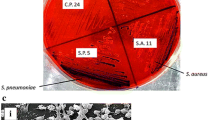Summary
The incidence of Branhamella catarrhalis in respiratory infections at City Hospital, Edinburgh from January 1981 to April 1984 is described. Beginning in January 1982 there was an increased incidence associated with a high proportion of β-lactamase- producing strains. The number of these strains increased: from January 1981 to April 1983, 61% of strains produced β -lactamase, and 83% produced β -lactamase from January to April 1984. 53% of patients were infected in hospital. Environmental studies showed that 7% of staff and 8% of patients were carriers; there was also circumstantial evidence of ward and patient- to- patient infection. The antimicrobial susceptibility of 54 clinical strains was tested: all strains were resistant to trimethoprim but were susceptible to clavulanic acid plus amoxycillin, chloramphenicol, erythromycin, co- trimoxazole, cefotaxime and cefuroxime. β -Lactamase- negative strains were uniformly susceptible to penicillin and ampicillin.
Similar content being viewed by others
References
Ahmad F, McLeod DT, Croughan MJ, Calder MA. Antimicrobial susceptibility of Branhamella catarrhalis isolates from bronchopulmonary infections. Antimicrobial Agents and Chemotherapy 26: 424–425, 1984
Ahmad F, Calder MA, Croughan MJ, Marshall TG. Urinary tract infection caused by Branhamella catarrhalis. Journal of Infection 10: 176, 1985a
Ahmad F, McLeod DT, Power JT, Calder MA. Branhamella catarrhalis prevalence in a hospital population. Journal of Hospital Infection 6: 71–74, 1985b
Bergey DH, Harrison FC, Breed RS, Hammer BW, Hintoon FM. Bergey’s Manual of Determinative Bacteriology. Williams & Wilkins, Baltimore, 1923
Blackwell CC, Young H, Anderson IS. Sensitivity of N. gonorrhoeae to partially purified R-type pyocine and possible approach to epidemiological typing. Journal of Medical Microbiology 12: 321–335, 1979
Catlin BW. Transfer of the organism named Neisseria catarrhalis to Branhamella gen. nov. International Journal of Systematic Bacteriology 20: 155–159, 1970
Darling WM. Branhamella catarrhalis. Lancet 1: 1244, 1982
Diamond LA, Lorber B. Branhamella catarrhalis, pneumonia and immunoglobulin abnormalities: a new association. American Review of Respiratory Diseases 129: 876–878, 1984
Doern GV, Siebers KG, Hallick LM, Morse SA. Antibiotic susceptibility of β-lactamase-producing strains of Branhamella (Neisseria) catarrhalis. Antimicrobial Agents and Chemotherapy 17: 24–29, 1980
Frosch P, Kolle W. Die Mikrokokken. In Flügge (Ed.) Die Mikroorganismen, 3rd ed., part 2, pp. 154–155, Verlag von Vogel, Leipzig, 1896
Ghon A, Pfeiffer H. Z. Klinicheskaya Meditsina 4: 262, 1902
Johnson MA, Lawrence WL, Roberts M. Branhamella catarrhalis: a lower respiratory pathogen? Journal of Clinical Microbiology 13: 1066, 1981
Lacey RW, Lord VL, Gunasekera HKW, Leiberman PJ, Luxton DEA. Comparison of trimethoprim alone with trimethoprim sulphamethoxazole in the treatment of respiratory and urinary infections with particular reference to selection of trimethoprim resistance. Lancet 1: 1270–1273, 1980
McLeod DT, Ahmad F, Power JT, Calder MA, Seaton A. Bronchopulmonary infection due to Branhamella catarrhalis. British Medical Journal 287: 1446–1447, 1983
Malmvall BE, Brorson JE, Johnson J. In vitro sensitivity to penicillin V and β-lactamase production of Branhamella catarrhalis. Journal of Antimicrobial Chemotherapy 3: 374–375, 1977
Ninane G, Joly J, Piot P, Kraytman M. Branhamella (Neisseria) catarrhalis as a pathogen. Lancet 2: 149, 1977
Ninane G, Joly J, Kraytman M. Bronchopulmonary infection due to Branhamella catarrhalis, 11 cases assessed by transtracheal puncture. British Medical Journal 1: 276–278, 1978
Percival A, Corkill JE, Rowland J, Sykes RB. Pathogenicity of and β-lactamase production of Branhamella (Neisseria) catarrhalis. Lancet 2: 1175, 1977
Slevin NJ, Aitken J, Thornley PE. Clinical and microbiological features of Branhamella catarrhalis bronchopulmonary infections. Lancet 1: 782–783, 1984
Stobberingh EE, Davies BI, Van Boven CPA. Branhamella catarrhalis: antibiotic sensitivities and β-lactamases. Journal of Antimicrobial Chemotherapy 13: 55–64, 1984
Thornley PE, Aitken J, Drennan CJ, MacVicar J, Slevin NJ. Branhamella catarrhalis infection of the lower respiratory tract: reliable diagnosis by sputum examination. British Medical Journal 2: 1537–1538, 1982
Wilson GS, Miles AA. Neisseria. In Topley & Wilson (Eds) Principles of bacteriology and immunity, p. 684, Edward Arnold, London, 1964
Author information
Authors and Affiliations
Rights and permissions
About this article
Cite this article
Colder, M.A., Croughan, M.J., McLeod, D.T. et al. The Incidence and Antibiotic Susceptibility of Branhamella catarrhalis in Respiratory Infections. Drugs 31 (Suppl 3), 11–16 (1986). https://doi.org/10.2165/00003495-198600313-00005
Published:
Issue Date:
DOI: https://doi.org/10.2165/00003495-198600313-00005




